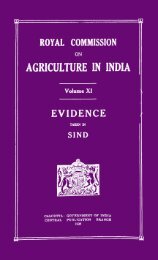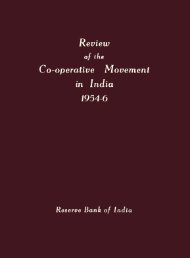All-India rural credit survey: District monograph, Osmanabad
All-India rural credit survey: District monograph, Osmanabad
All-India rural credit survey: District monograph, Osmanabad
Create successful ePaper yourself
Turn your PDF publications into a flip-book with our unique Google optimized e-Paper software.
CREDIT NEEDS OF AGRICULTURE 35<br />
Nevertheless, the smaller cultivators resort to borrowing for meeting the current<br />
farm expenditure to a much greater extent than do the bigger cultivators; 21· 7<br />
per cent of the current farm expenditure by the smaller cultivators was met by<br />
borrowing while only 9·6 per cent of the similar expenditure by the bigger cultivators<br />
was met by borrowing. The smaller cultivators also show a peculiar feature;<br />
the extent to which they borrow is actually much larger in the first period than in<br />
the second period. Among the different items of expenditure, the smaller cultivators<br />
need <strong>credit</strong> most for the purchase of manure, purchase of seed and purchase of<br />
fodder in that order. Most of the purchases of seed and fodder occur only during<br />
the first period and hence the smaller cultivators are seen to borrow to a greater<br />
extent during this period. As for the bigger cultivators, they are seen to borrow<br />
to a greater extent for purchase of seed and also for the payment of cash wages.<br />
In fact, in the second period, most of their borrowing was for payment of cash wages.<br />
A large amount of expenditure has been shown unclassified under' other cash expenditure'.<br />
It is Rs 389·5 for the bigger cultivators and Rs 82·4 for the smaller cultivators.<br />
Two major items included in this are salaries of annual farm servants and<br />
cash rents paid to landlords. In the case of the bigger cultivators, they amount<br />
to Rs 142·3 and Rs 153·4, respectively. In the case of the smaller cultivators they<br />
amount to Rs 23·9 and Rs 16·1, respectively. Presumably, both these items of<br />
expenditure are incurred when the cash position is comparatively easy and hence<br />
they do not cause borrowing to any great extent. Considering the entire item of<br />
'other cash expenditure' only about 4 per cent of it was financed by borrowing by<br />
both the bigger and smaller cultivators.<br />
TABLE 4.'-DISTRIBUTION OF AMOUNT BORROWED AND FULLY REPAID<br />
DURING THE YEAR ACCORDING TO THE MONTH OF BORROWING<br />
AND REPAYMENT<br />
[Intensive enquiry data.. Amount in rupees per family]<br />
UPPER STRATA LOWER STRATA ALL CULTIVATORS<br />
Month Borrow· Repay. Borrow· Repay- Borrow- Repay.<br />
ingB menta ings menta ings mente<br />
1 2 3 4 5 6<br />
April, 1951 ................. 20·6 11·7 16·2<br />
May ..•.................... 6·3 3·2<br />
June .......................<br />
July .......................<br />
August ..................... 16·1<br />
.-<br />
6·9 11·5<br />
September .•................ 1·4 0·7<br />
October .•.................. 18·2 0·9 10·1 14·1 0·'<br />
November ..................<br />
December .................. 1·4 0·7<br />
_.<br />
January, 1952 .............. 15·1 13·3 7·6 6·7<br />
February ................... 24·1 0·9 21·8 0·4 23·0<br />
March ...•................. 33·1 15·5 24·3<br />
Not specified .•.••...........<br />
Total ..•.•............ 71·4 71·4 37·3 37·3 54·4 54·4.




